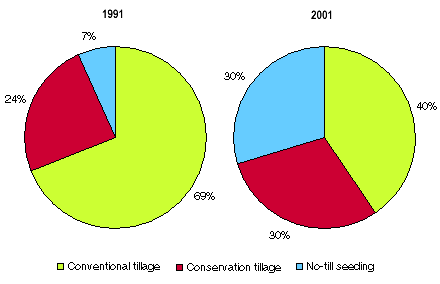All
releases > Canadian farm operations >
Land management
Conservation tillage and no-till seeding more common
Manure: Nature's renewable nutrient
Conservation tillage and no-till seeding more common
Canadian farmers have been looking for ways to keep
their costs down and new or rediscovered land management practices are
proving to be one solution. Numbers show that farmers are using more and
more environmentally friendly practices to minimize wind and water erosion
and soil compaction. But farmers benefit as well as the environment. Practices
such as conservation tillage minimize the number of passes farmers make
over their fields, which in turn reduces the number of hours spent in
each field, decreases fuel costs and lowers carbon dioxide emissions.
The time saved allows a farmer to crop more land in the same amount of
time using the same equipment.
Conservation tillage and no-till seeding techniques
combine to overtake conventional tillage

More Canadian farmers are preparing their land for seeding
using no-till seeding and conservation tillage methods, which leave some
stubble on the surface to protect the soil from wind and water erosion,
and retain moisture. This ability to retain moisture allows farmers to
convert summerfallow land to cropland and is particularly important in
years of drought. The extent to which no-till seeding or conservation
tillage methods can be used depends on the soil type and crop.
Use of conservation tillage and no-till seeding techniques
first appeared in significant proportions in 1991. The trend was confirmed
in 1996, and in 2001, 44.4% of farms reporting tillage practices were using
these methods. More importantly, the area where no-till or conservation
tillage was used accounted for 59.5% of all area tilled. These practices
have the longest tradition in the Prairie provinces, but in 2001 the Atlantic
provinces, Ontario and Quebec all reported significant increases, with
the exception of no-till in Prince Edward Island. Potatoes cannot be grown
using current no-till techniques.
With the growth in animal numbers, Canadian farmers
are looking for more environmentally and neighbour-friendly ways to dispose
of manure. Manure is a natural alternative to commercial fertilizers.
Whether or not manure is a practical substitute for chemical fertilizers
depends on the quantity and the distance it would have to be transported.
In 2000, manure was spread over 6.7 million acres, an increase of 5.5%
compared with five years ago.
In many parts of Canada, more stringent regulations are being implemented
for livestock operations as public pressure to improve water quality
grows. Quebec and parts of British Columbia already have environmental
regulations in place for manure disposal similar to those in Europe, where
restrictions are tight.
Since the last census, the area spread with fertilizers
was down, suggesting a shift from fertilizers to manure. Farmers may use
one or a combination of methods to spread manure. Spreading solids was
the most common method in 2000 as it had been in 1995: it was used on
67.2% of the area to which manure was applied compared with 73.0% of the
total area in 1995.
Of the two liquid-spreading methods — surface or
injected — surface spreading accounts for 85.0% of liquid-spread
area. Injecting manure directly into the soil is considered the most environmentally
friendly method and its area increased 145.2%.
Dried or composted manure for urban gardeners and nurseries
is also a product of livestock operations.
Next > |

































